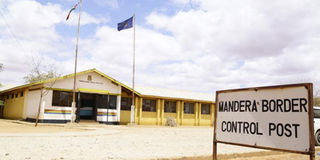In defence of ‘smuggling’ and Africa’s porous borders: all our untold stories

Mandera border post. A chief in Mandera County was Thursday killed by Al-Shabaab terrorists, hours after they pulled him out of a bus and took him to Somalia. FILE PHOTO | MANASE OTSIALO | NATION MEDIA GROUP
What you need to know:
- Parts of the border will forever be disputed, but even where there is agreement, there is a gulf between the local “social” consensus on where the border is and what the map coordinates say. Thus in a meeting, the two sides will agree on the coordinates.
- To begin with, they are an anti-colonial statement, the way in which Africa upholds the 1884-1885 Berlin Conference, where imperial borders arbitrarily carved up the continent, while at the same time rejecting it.
- Porous borders allow communities on the famine-hit or drought-ravaged side of a boundary to cross and find sustenance in a neighbouring country.
So, Kenya is moving to build an anti-terror wall along its border with Somalia. A lot of things, especially about whether the wall makes sense, have been said, but it fascinates me for different reasons.
First, will Kenya and Somalia agree on where their borderlines are? If they do, it would be one of the very few times there was quick agreement in Africa about borders. The African Union’s Peace and Security Commission has a documentary on what happens when you try to agree on borders in Africa.
It is insightful and hilarious in equal measure. Get your hands on it.
Someone at the AU told me the difficulties they have had getting Sudan and South Sudan to agree on their borders. Parts of the border will forever be disputed, but even where there is agreement, there is a gulf between the local “social” consensus on where the border is and what the map coordinates say. Thus in a meeting, the two sides will agree on the coordinates.
The headache is when they get to the ground, because the communities — and authorities — at the border do not go by coordinates. They go by hills, anthills, rocks, streams, trees, and things like that.
So, if at the Kenya-Uganda border the people and local officials “have always known” that the river is the border, then you bring your map with its coordinates and say, no, the river is actually one kilometre inside Uganda and the south bank is not Kenya’s, you have a war on your hands.
MAP IS RIGHT
The map is right, but it goes against 100 years of community consensus. And that brings us to this whole issue of “porous” borders. Analysts, journalists and writers like to speak about Africa’s “porous” borders, and after Al-Shabaab massacred over 140 Kenyan students at Garissa University College two weeks ago, “porous” was one of the most used words.
Porous borders are a political necessity. To begin with, they are an anti-colonial statement, the way in which Africa upholds the 1884-1885 Berlin Conference, where imperial borders arbitrarily carved up the continent, while at the same time rejecting it.
A little story will illustrate it. Omwony Ojwok was a leading left-leaning Ugandan academic and later politician. He died in 2007. He was a very clever man who spoke many languages, including Latin, fluently.
While he was lecturing at Oxford University, he made friends with a Somali scholar. When he told the Somali which village he came from in Uganda’s nomadic Karamoja region, the fellow immediately knew it.
He had never been there, but in the 1960s and 1970s the Karamoja village was very popular with the cattle rustlers in his own village in Somalia. Because Uganda does not share a border with Somalia, this means that there was a network of rustlers that was able to steal cattle in northern Uganda, transport the animals through northern Kenya and into Somalia.
FIND SUSTENANCE
While that is illegal activity, you could argue that the cattle rustlers also established a spiritual connection between Karamoja and Somalia. Porous borders allow communities on the famine-hit or drought-ravaged side of a boundary to cross and find sustenance in a neighbouring country.
They allow goods to move from the country where they are plentiful to the neighbouring one where they are scarce. They enable sensible commerce — e.g. cheap fuel from Kenya to be transported and sold across the border in Uganda, where prices are prohibitive. Big government elites call it “smuggling”, but for the small people it is good business practice.
Porous borders allow Africans to escape being murdered by rebels, government armies, or opposition rivals during disputed elections, quickly fleeing to the safety of neighbouring countries without having to make long queues at immigration control, where their enemies might find and kill them.
Nigeria has about 50 official border crossings with its neighbours. A study found that there were over 3,000 fairly established unofficial ones, where most of the trade took place.
The fact that murderers are able to move across the borders, as in the case of Kenya-Somalia, just poisons the well and, hopefully, a security solution will be found to it. In the meantime, though, people should stop giving our “porous” borders a bad name. Without that porousness, most African countries would be in deeper crises.
The author is editor of Mail & Guardian Africa (mgafrica.com). Twitter@cobbo3





